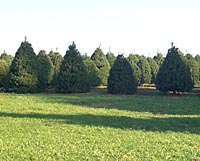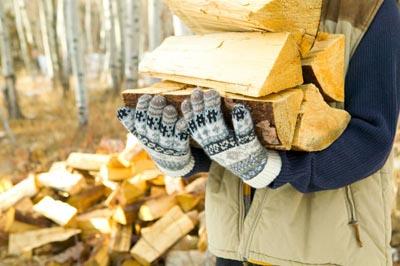Agroforestry Combines Trees and Traditional Farm Enterprises
Agroforestry Combines Trees and Traditional Farm Enterprises

If Deborah Hill has her way, Kentuckians will hear a lot more about agroforestry in the days to come. It’s not that agroforestry is a new concept. On the contrary, Hill says the practice of integrating tree crops with more traditional agronomic crops or livestock has been around “for millennia.”
Agroforestry is, however, becoming increasingly recognized as a viable farming enterprise in Kentucky.
“It is one of those ideas whose time has come,” said Hill, Extension forestry specialist at the University of Kentucky College of Agriculture.
As Kentucky farmers face changes in the agricultural landscape, agroforestry enables them to diversify their income sources. At the same time, it protects the valuable natural resources upon which they are so dependent. And the more economically diverse and environmentally sound a farming operation is, the more sustainable it is, Hill said.
“It’s so connected with sustainability that I think it’s a really important thing for us to do more of,” she said.
Put simply, agroforestry is an intensive land management system that combines long-term tree crops with annual agronomic crops and/or livestock in a farm operation. It has been practiced in tropical areas of the world for centuries, but only in the past 20 years has it become an accepted practice in temperate regions of the world.
“For farmers, this is very definitely thinking outside the box. It is not the box,” Hill said.
There are five agroforestry techniques that have been successfully incorporated into the traditional agricultural systems of the United States. They are alley cropping, forest farming, silvopasture, riparian buffer strips and windbreaks. Each is designed to provide a marketable commodity, such as nuts and firewood, as well as provide less tangible benefits, such as erosion control and shade for livestock.
Two of the agroforestry techniques – forest farming and riparian buffer strips – are especially applicable in Kentucky. A third, silvopasture, has limited use but mostly in the western part of the state, Hill said.
Forest farming probably is the most widely used agroforestry practice in the state, said Hill, who has been working in that field for several years. It varies from the other four techniques because farmers “manipulate” existing wooded areas to produce short-term or annual crops. With the others, trees must be introduced into a pasture or large open area for the same purpose.
“When you’re talking about forest management, most people think in terms of timber, which is a very long-term way of producing income from the land,” Hill said. “When you’re talking about forest farming, you’re talking about a variety of things that can be done either on an annual basis or certainly a much more short-term basis than timber management.” Those include bee products, exotic mushrooms, fuel wood, fence posts, and medicinal plants. “And maple syrup – most people don’t realize you can, in fact, produce maple syrup from any kind of maple tree. We certainly have a variety of them that grow in Kentucky,” Hill said.
Those include bee products, exotic mushrooms, fuel wood, fence posts, and medicinal plants. “And maple syrup – most people don’t realize you can, in fact, produce maple syrup from any kind of maple tree. We certainly have a variety of them that grow in Kentucky,” Hill said.
In addition, Hill said forest farming is the one agroforestry technique in which a producer could expect to see a marketable product within a year or two. It may, however, require “more kinds of expertise” than the others.
Riparian buffer strips, also called stream management areas, are trees, shrubs and grasses planted near streams and rivers that act as “living filters.” They can protect the water from surface runoff, control erosion and provide wildlife habitat. Many farmers have developed buffer strips as a result of the Kentucky Agriculture Water Quality Act of 1994. However, buffer strips can be managed to provide economic as well as environmental benefits.
“You could put walnut (trees) down next to the stream, which is going to give you nuts. You could probably do some kind of orchard trees on the farthest outside edge of the trees. … Choices for the shrub layer could be something croppable like red osier dogwood or corkscrew willow, because when you cut them off they will re-sprout,” Hill said.
The key to generating income from a buffer strip – or any agroforestry enterprise, for that matter – is to “choose your weapon,” she added. It is important to choose species that are compatible with each other and with other crops and livestock but also species that can generate income from a short-term or annual product.
Silvopasture, though more suitable to the western Kentucky landscape, is also a potential agroforestry option for many of the state’s farmers, Hill said. It is the combination of trees, forage and livestock in a single integrated operation.
Ideally, the trees in a silvopasture operation are planted near existing fence lines, rather than in the middle of a pasture. They should be species that are marketable, whether for their nuts, fruit or wood products. At the same time, however, the trees can be used to provide shade for livestock and windbreaks for agronomic crops.
“It’s really one of the most diverse techniques,” Hill said. “Given the fact that we have a huge cattle population, maybe silvopasture will take off.”
The other two agroforestry techniques, alley cropping and windbreaks, have fewer applications in Kentucky. Alley cropping involves planting single or double rows of long-term trees with wide alleys between them. An agronomic crop, such as soybeans or corn, is then planted in the alleys. Windbreaks are rows of trees that provide agronomic crops and/or livestock with protection from wind and soil erosion.
Although agroforestry has garnered much interest throughout the United States, Hill admits that, for many farmers, it is a different way of approaching land management.
“You have generations of farmers who think that putting trees in their pastures or planting trees for any purpose is the worst thing in the world to do because they’ve been trying to get rid of trees ever since they bought their land,” she said. “So it’s one of those things we call paradigm shifts. You have to think about it differently.”
Hill also suggests that agroforestry is more suitable for small, family farms rather than agribusinesses. But in Kentucky, a state dominated by small-scale farming, that shouldn’t be a roadblock to further agroforestry development, she said.
“My goal is to see more agroforestry implemented in the state to help farmers stay on their farms because they’re making their whole operations more economically viable."
